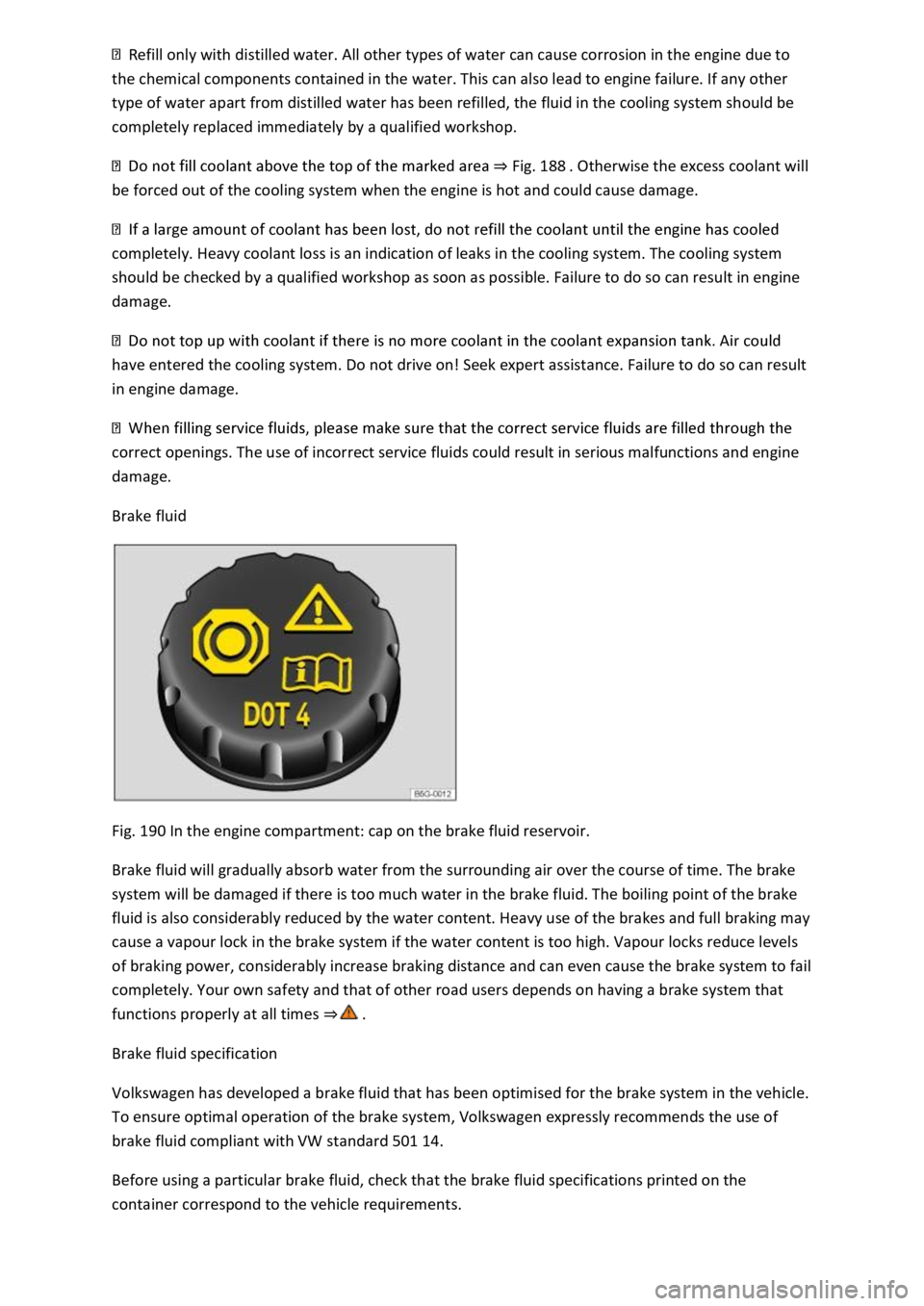2021 VOLKSWAGEN T-ROC oil
[x] Cancel search: oilPage 375 of 502

With the engine at operating temperature, park the vehicle on a level surface to ensure that the
engine oil reading is correct.
Switch off the engine and wait a few minutes for the engine oil to flow back into the sump.
Open the bonnet In the engine compartment.
Identify the engine oil filler cap and oil dipstick. The engine oil filler opening can be recognised by
the symbol on the cap and the oil dipstick has a coloured handle. If you cannot find the cap and
dipstick, please contact a qualified workshop.
Pull the dipstick out of the guide tube and wipe it off with a clean cloth.
Insert the oil dipstick into the guide tube again as far as it will go. If there is a marking on the upper
end of the oil dipstick, this marking must fit into the corresponding groove at the top end of the
guide tube upon insertion.
Ⓐ Engine oil
level too high. Observe any messages that are shown on the instrument cluster display or contact a
qualified workshop . Ⓑ Do not fill any engine oil . Continue with step 16. Ⓒ Engine oil level OK.
Engine oil can, e.g. in the case of high engine loads , be filled up to the upper limit of this range.
Continue with step 8 or 16. Ⓓ Engine oil level is too low. Engine oil must be filled. Continue with
step 8.
After reading off the oil level, push the oil dipstick back into the guide tube as far as it will go.
Unscrew the cap of the engine oil filler opening .
Using only the engine oil approved by Volkswagen expressly for this engine, fill oil gradually in small
amounts (no more than 0.5 l).
Page 376 of 502

In order to avoid overfilling, wait for approximately one minute after each refill step to allow the
engine oil to flow into the sump up to the marking on the engine oil dipstick.
Read the engine oil level from the dipstick again before refilling with a further small quantity of
engine oil. Never overfill engine oil .
After refilling, the engine oil level should be in the middle of area Ⓒ. It should not be above Ⓒ, in
area Ⓑ, and must not be in area Ⓐ .
If too much engine oil has been added unintentionally and the engine oil level is in area Ⓐ, do not
start the engine. Inform a qualified workshop and seek expert assistance if necessary.
Close the engine oil filler opening with the cap after filling.
Insert the oil dipstick into the guide tube as far as it will go. If there is a marking on the upper end of
the oil dipstick, this marking must fit into the corresponding groove at the top end of the guide tube
upon insertion.
Close the bonnet In the engine compartment.
WARNING
Engine oil can ignite if it comes into contact with hot engine components. It can cause fires, burns
and other serious injuries.
up and ignite when the engine is running.
dipstick is properly inserted back into the guide tube. This will prevent the engine oil from draining
out on to hot engine components when the engine is running.
NOTICE
⇒ Fig. 186 Ⓐ, do not start the engine. Inform a qualified workshop and seek expert assistance if
necessary. The catalytic converter and the engine could otherwise be damaged.
Page 377 of 502

correct openings. The use of incorrect service fluids could result in serious malfunctions and engine
damage.
The engine oil level must never be above area ⇒ Fig. 186 Ⓑ. Otherwise oil can be drawn in through
the crankcase breather and escape into the atmosphere via the exhaust system.
Troubleshooting
First read and observe the introductoryinformation and safety warnings⇒Introduction
and Engine oil pressure too low
The central warning lamp lights up red and the text message Stop vehicle. Oil pressure. Observe
vehicle wallet is displayed.
Do not drive on!
Switch off the engine and check the engine oil level. Checking the engine oil level ⇒ Checking the
engine oil level and refilling the engine oil . - Do not drive on or allow the engine to run if the
warning lamp is flashing although the engine oil level is correct. The engine could otherwise be
damaged. Seek expert assistance.
and Engine oil level too low
The central warning lamp lights up red and the text message Refill engine oil. is displayed.
Engine oil level is too low. Switch off the engine.
Checking the engine oil level ⇒ Checking the engine oil level and refilling the engine oil .
and Engine oil level low
The central warning lamp lights up yellow and the text message Check oil level. is displayed.
Engine oil level is low. Switch off the engine.
Checking the engine oil level ⇒ Checking the engine oil level and refilling the engine oil .
and Fault in engine oil system
The central warning lamp lights up yellow and the text message Oil sensor: workshop. is displayed.
Engine oil system is faulty. Go to a qualified workshop and have the engine oil sensor checked.
and Engine oil level too high
The central warning lamp lights up yellow and the text message Reduce oil level. is displayed.
Engine oil level is too high. Switch off the engine.
Check the engine oil level. Checking the engine oil level ⇒ Checking the engine oil level and refilling
the engine oil . Seek expert assistance.
Page 379 of 502

The coolant additive is dyed purple. The mixture of water and a coolant additive offers anti-freeze
protection down to -25°C (-13°F), protects the alloy parts in the cooling system against corrosion,
prevents limescale deposits and significantly increases the boiling point of the coolant.
When refilling the coolant, a mixture of distilled water and at least 40% coolant additive - G 13 - or -
G 12 plus-plus - (TL-VW 774 G) (both of which are dyed purple) must be used in order to obtain the
optimum corrosion protection ⇒ .
Mixing - G 13 - with the coolant additives - G 12 plus - (TL-VW 774 F), - G 12 - (dyed red) or - G 11 -
(dyed blue-green) will significantly decrease the level of corrosion protection and should therefore
be avoided ⇒ .
WARNING
Insufficient anti-freeze in the coolant system can cause the engine to break down and cause serious
injuries.
ive used must be sufficient for the lowest
ambient temperature that you expect the vehicle to be exposed to.
Vehicle occupants with inadequate winter clothing could then freeze to death as the heating will
also no longer function.
NOTICE
Never mix genuine coolant additives with other coolants that have not been approved by
Volkswagen.
ts from mixing the purple
coolant additive with distilled water) but for example, brown instead of purple, - G 13 - has been
mixed with an unsuitable coolant additive. The coolant must be changed as soon as possible if this is
the case. Failure to observe this warning can result in serious malfunctions or damage to the engine
and cooling system.
Coolant and coolant additives can pollute the environment. Spilt service fluids must be collected and
then disposed of properly and in an environmentally responsible way.
Checking the coolant level and refilling coolant
Page 382 of 502

Refill only with distilled water. All other types of water can cause corrosion in the engine due to
the chemical components contained in the water. This can also lead to engine failure. If any other
type of water apart from distilled water has been refilled, the fluid in the cooling system should be
completely replaced immediately by a qualified workshop.
⇒ Fig. 188 . Otherwise the excess coolant will
be forced out of the cooling system when the engine is hot and could cause damage.
completely. Heavy coolant loss is an indication of leaks in the cooling system. The cooling system
should be checked by a qualified workshop as soon as possible. Failure to do so can result in engine
damage.
have entered the cooling system. Do not drive on! Seek expert assistance. Failure to do so can result
in engine damage.
correct openings. The use of incorrect service fluids could result in serious malfunctions and engine
damage.
Brake fluid
Fig. 190 In the engine compartment: cap on the brake fluid reservoir.
Brake fluid will gradually absorb water from the surrounding air over the course of time. The brake
system will be damaged if there is too much water in the brake fluid. The boiling point of the brake
fluid is also considerably reduced by the water content. Heavy use of the brakes and full braking may
cause a vapour lock in the brake system if the water content is too high. Vapour locks reduce levels
of braking power, considerably increase braking distance and can even cause the brake system to fail
completely. Your own safety and that of other road users depends on having a brake system that
functions properly at all times ⇒ .
Brake fluid specification
Volkswagen has developed a brake fluid that has been optimised for the brake system in the vehicle.
To ensure optimal operation of the brake system, Volkswagen expressly recommends the use of
brake fluid compliant with VW standard 501 14.
Before using a particular brake fluid, check that the brake fluid specifications printed on the
container correspond to the vehicle requirements.
Page 420 of 502

On wheels with a wheel cover, the anti-theft wheel bolt must be screwed into position
⇒ Fig. 204② or ③ according to the position of the tyre valve ①. The wheel cover can otherwise
not be fitted.
Tightening torque of wheel bolts
Specified tightening torque for wheel bolts for steel or alloy wheels:
Nm
If the wheel bolts are corroded and difficult to turn, they must be replaced before the tightening
torque is checked and the wheel hub threads cleaned.
Never grease or oil the wheel bolts or the threads of the wheel hub.
The tightening torque should be checked with a properly functioning torque wrench immediately
after changing a wheel.
WARNING
Incorrectly tightened wheel bolts can loosen while the vehicle is in motion and cause accidents,
serious injury, and loss of control of the vehicle.
easily.
bolts.
the wheel bolts only by approximately one turn before raising the vehicle with the vehicle
jack.
loosen while the vehicle is in motion, even if they have been tightened with the specified tightening
torque.
-on rings.
while the vehicle is in motion. The wheel bolts and the threads could be damaged if the tightening
torque is too high. Check the tightening torque regularly using a torque wrench.
WARNING
The wrong wheel bolts can loosen while the vehicle is in motion and cause accidents, serious injury,
and loss of control of the vehicle.
Page 424 of 502

-theft wheel bolt using the adapter at position ⇒ Fig. 204② or ③ and tighten it
slightly in a clockwise direction.
l the other wheel bolts in clockwise direction and tighten them slightly.
⇒ . Do not
tighten the bolts in order but always in diagonally opposite sequence.
⇒ Hubcaps .
WARNING
Incorrect tightening torque or incorrect use of wheel bolts can lead to a loss of control of the vehicle,
and cause accidents and serious injuries.
ep all wheel bolts and threads in the wheel hubs clean and free from oil and grease. The
wheel bolts must be easy to turn and be tightened to the specified torque.
not use
for loosening or tightening them.
After changing a wheel
First read and observe the introductoryinformation and safety warnings⇒Introduction
luggage compartment ⇒ Vehicle toolkit .
⇒ Tightening torque of wheel
bolts .
as possible.
After changing a wheel, the indicator lamp for the tyre monitoring system may indicate a fault in the
system ⇒ Troubleshooting for Tyre Pressure Loss Indicator .
Breakdown set
Introduction
This chapter contains information on the followingsubjects:
⇒ Contents of the breakdown set
⇒ Preparations
⇒ Sealing and inflating tyres
Page 429 of 502

Remove any items of luggage from the luggage compartment.
Take the breakdown set out of the luggage compartment.
Take the sticker ① from the breakdown set and stick it on the dash panel within the driver's field
of vision.
Do not remove foreign objects (e.g. screws or nails) from the tyre.
WARNING
Ignoring any of the items on this important safety checklist can lead to accidents and severe injuries.
Sealing and inflating tyres
First read and observe the introductoryinformation and safety warnings⇒Introduction
Sealing a tyre
⇒ Fig. 208⑤ to unscrew the valve core from the tyre valve. Place
the core on a clean surface.
⇒ Fig. 208③ vigorously to and fro several times.
⇒ Fig. 208② tightly onto the tyre filler bottle in a clockwise direction. The
plastic foil on the closure is pierced automatically.
⇒ Fig. 208② and place the open end fully on the tyre valve.
⇒ Fig. 208⑤ to screw the valve core back into the tyre valve.
Inflating the tyre
⇒ Fig. 209④ of the air compressor tightly onto the tyre valve.
⇒ Fig. 209② is closed.
-volt plug ⇒ Fig. 209⑤ into one of the vehicle's 12-volt sockets ⇒ Electrical sockets .